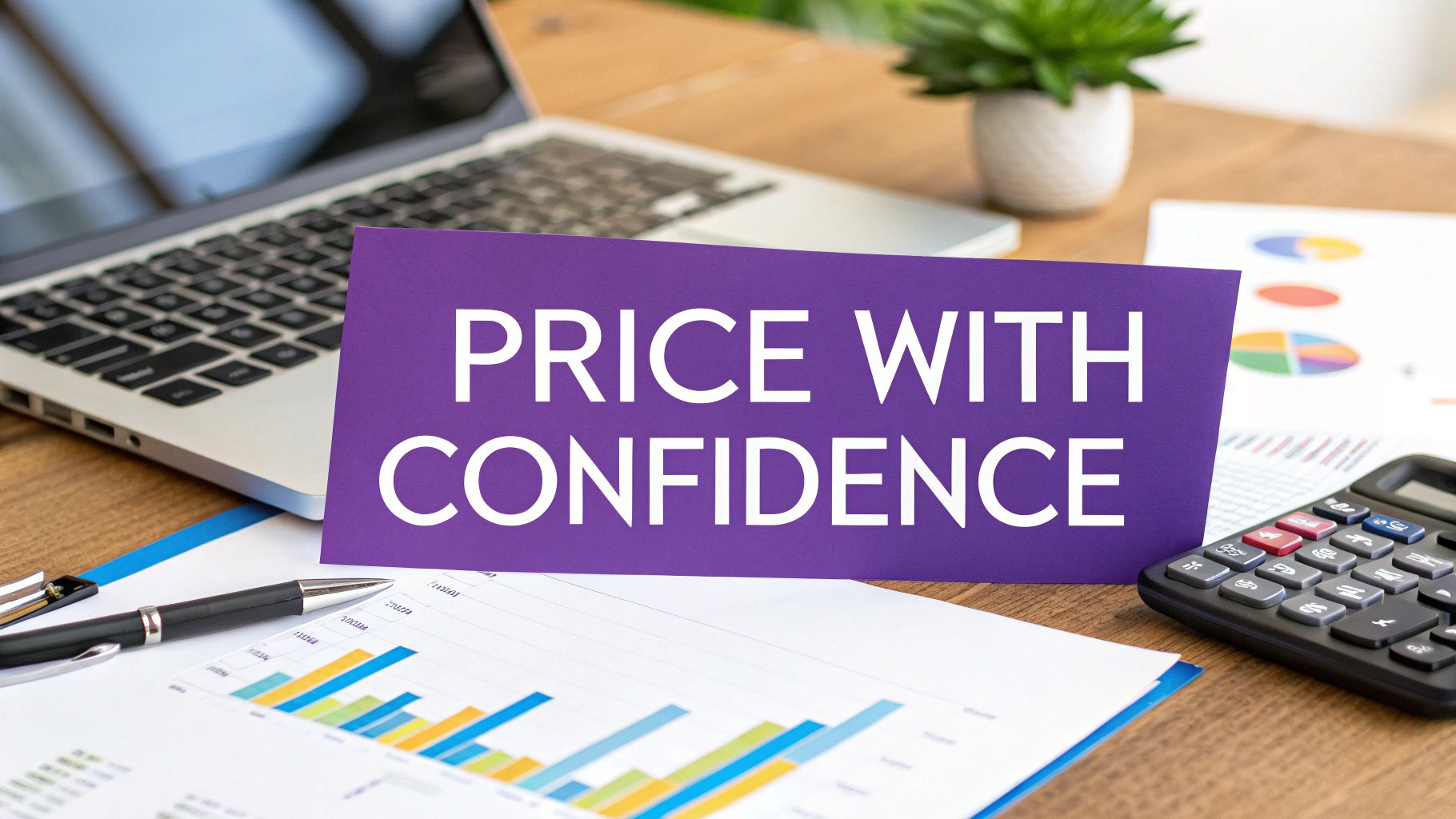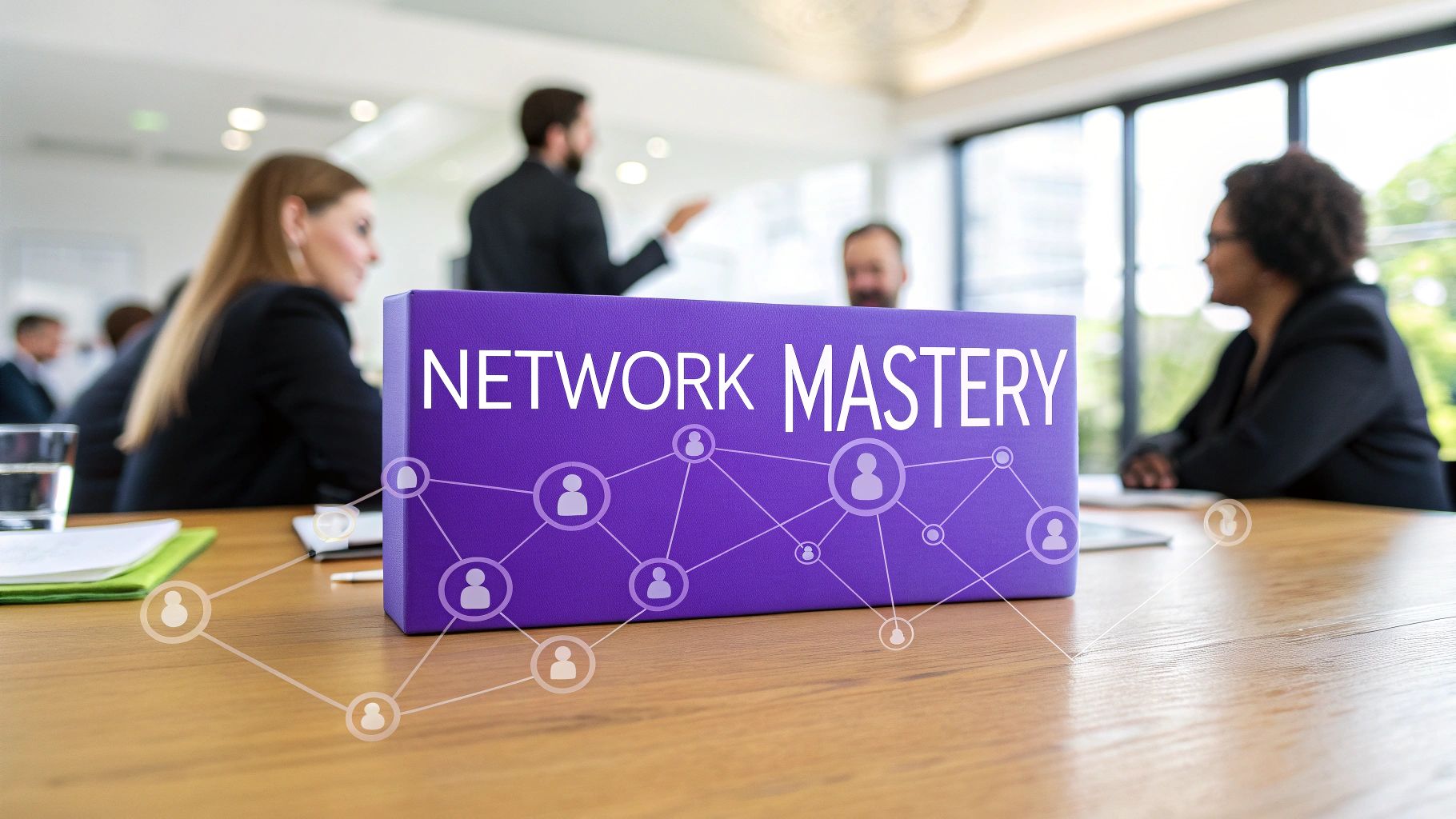How to Develop Communication Skills for Career Success

Improving your communication skills isn't a one-and-done task. It’s an active, ongoing process that comes down to mastering four key areas: verbal, nonverbal, written, and listening. Real improvement happens when you move beyond theory and start making deliberate practice a part of your daily professional life. That's how you'll truly transform the way you connect with people and get things done.
Why Communication Skills Are Your Career Superpower
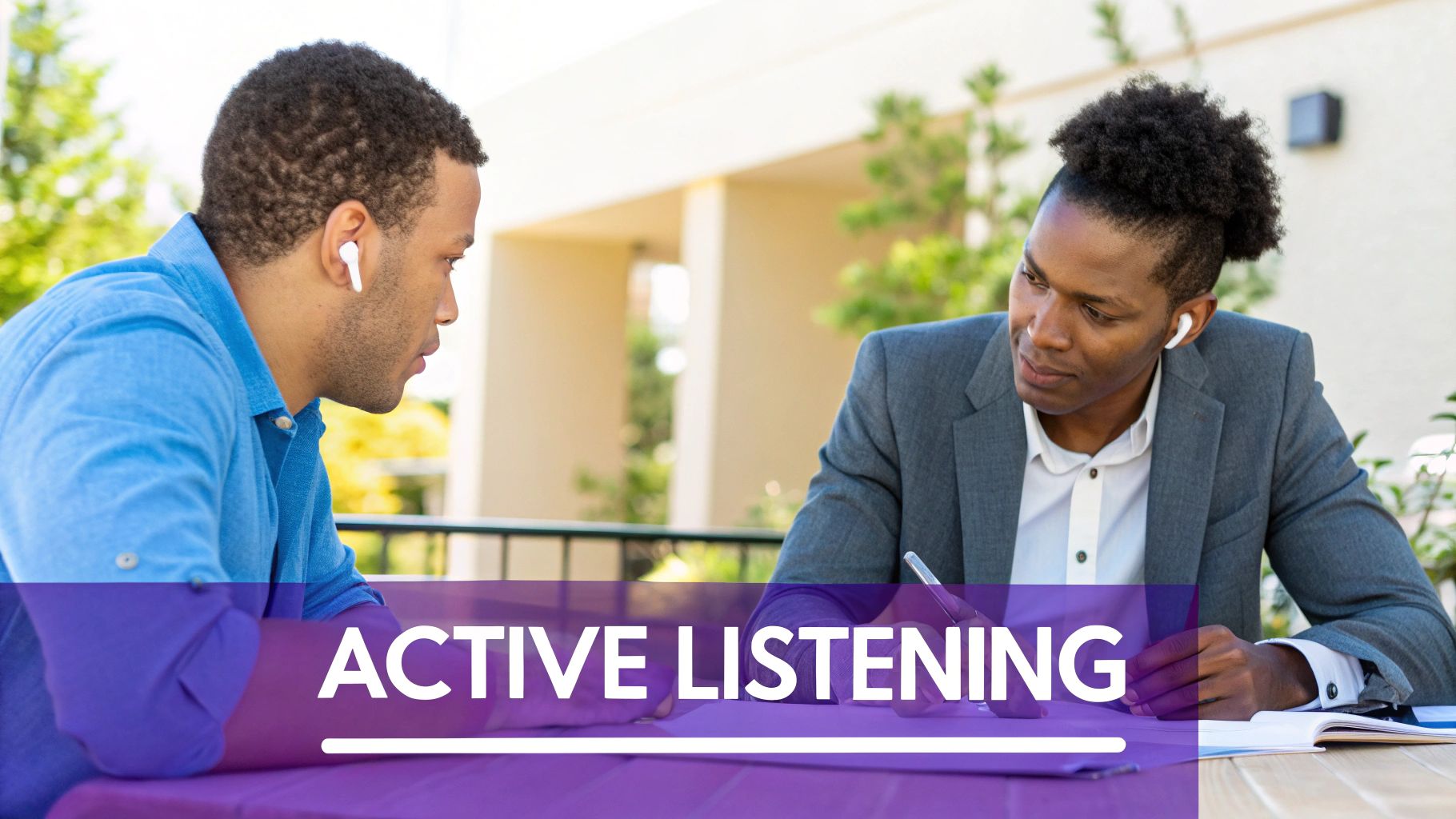
Let's be real: your technical expertise, no matter how brilliant, can only get you so far. Real career momentum comes from something far more fundamental—your ability to communicate effectively with colleagues, clients, and leaders. It’s the invisible thread connecting your ideas to actual outcomes, turning individual effort into collective success.
This isn't just about sounding polished in meetings. It's about making sure your message lands exactly as you intended—that it’s received, understood, and acted upon. When communication breaks down, the fallout is swift and damaging.
The Real Cost of Poor Communication
Picture a project kickoff that goes completely off the rails. The project manager rushes through the goals, a key stakeholder is texting under the table, and a remote team member can't get a word in because of a bad connection. Everyone leaves the room with a totally different idea of what to do next.
This isn't some rare, hypothetical scenario. In fact, a staggering 86% of employees point to poor communication as a primary reason their companies fail to hit their goals. Ineffective communication isn't just a minor frustration; it’s a massive barrier to success that leads to delayed projects, widespread confusion, and a serious drop in team morale. This problem costs U.S. businesses an estimated $1.2 trillion annually, proving just how expensive it is when messages get lost in translation.
The ability to articulate a vision, give clear feedback, and genuinely listen is what separates a good employee from an indispensable leader. It's the engine of collaboration and the bedrock of trust.
The Four Pillars of Communication at a Glance
To build communication skills that actually make a difference, you need a balanced approach. Focusing on these four distinct but interconnected pillars will help you become a more well-rounded and effective communicator.
Here’s a quick summary of what each pillar involves and where you can focus your efforts for improvement.
| Communication Type | Key Components | Improvement Focus |
|---|---|---|
| Verbal | Clarity, tone of voice, pacing, storytelling | Structuring thoughts logically, reducing filler words |
| Nonverbal | Body language, facial expressions, eye contact, posture | Projecting confidence, showing engagement, reading social cues |
| Written | Emails, reports, instant messages, clarity, conciseness | Crafting clear and professional messages, avoiding ambiguity |
| Listening | Active listening, empathy, understanding intent | Focusing on the speaker, asking clarifying questions, showing you understand |
Each of these pillars plays a critical role in shaping how you are perceived and how effective you are in your role.
Mastering these pillars is essential for everything from daily check-ins to career-defining moments. For example, knowing how to present yourself clearly and confidently is key to ace a video interview and get hired.
Ultimately, strong communication is also the foundation for learning how to build professional relationships that can support your career for years to come. By honing these skills, you’re not just checking a box—you’re investing in your long-term reputation and success.
Improving Your Verbal and Nonverbal Presence
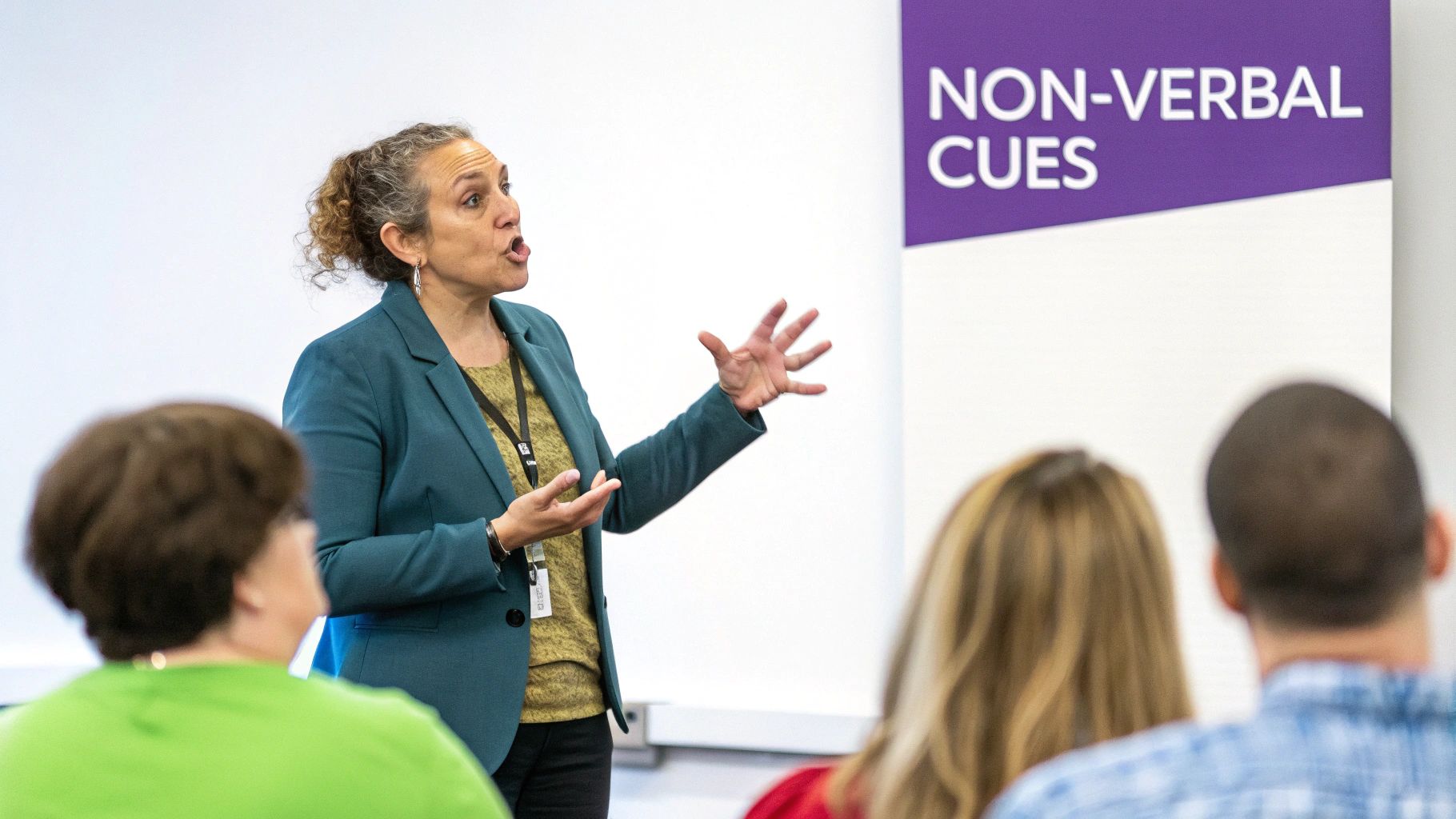
Ever had a brilliant idea that just… fell flat? You know the feeling. The concept is solid, but the delivery doesn't land, and you watch your moment slip away. That gap often comes down to one thing: presence. It’s how you use your voice, body, and structure to command a room and radiate confidence.
Boosting your verbal and nonverbal skills isn’t about faking it or becoming someone you’re not. It’s about making sure your external presence matches your internal expertise, so your ideas get the attention they deserve.
Structure Your Thoughts for Maximum Clarity
Rambling is the ultimate confidence killer. When your thoughts are jumbled, filler words sneak in, and you can practically feel the audience tuning out. A simple but incredibly effective way to fix this is the "What, Why, and How" framework.
This little trick forces you to be direct and logical. Before you speak up in a meeting or pitch an idea, take a second to organize your thoughts into these three buckets:
- What: Start with your main point. What’s the single most important thing they need to know? Lead with your conclusion instead of burying it.
- Why: Now, explain why it matters. Give them the context, the benefit, or the problem this solves. This is where you get their buy-in.
- How: Finally, outline the next steps. How do we make this happen? This gives everyone a clear, actionable path forward.
Using this framework keeps you from getting lost in the weeds and makes your message crystal clear.
Eliminate Distracting Filler Words
We all do it. Words like "um," "uh," "like," and "you know" pop up when our brain is trying to catch up with our mouth. While it's normal in casual conversation, leaning on them too heavily can make you sound hesitant and unprepared.
The solution is a two-step process: awareness and the power of the pause.
First, you have to realize you're even doing it. A great way to build this awareness is to record yourself. Grab your phone and record a one-minute pitch on any topic—your current project, a favorite book, anything.
Listen back, but only for the filler words. It can be cringe-worthy, but hearing yourself will make you hyper-aware of the habit in real conversations. Once you’re aware, you can start swapping those "ums" and "ahs" for a brief, silent pause. Trust me, a moment of silence sounds far more thoughtful than a filler word ever will.
Key Takeaway: A strategic pause isn't awkward; it’s powerful. It gives you a second to gather your thoughts and adds weight to whatever you say next.
Master Your Nonverbal Communication
Sometimes, what you don't say speaks the loudest. Research consistently shows that a huge chunk of our communication is nonverbal—some studies suggest it's as high as 93%. It’s your posture, gestures, and facial expressions. There’s a reason employers rank communication skills so highly, scoring them around 4.56 on a 5-point scale for new hires. They know how you carry yourself is just as important as what you say.
Here are three key areas to work on:
- Maintain Authentic Eye Contact: This isn't a staring contest. Aim for relaxed, natural eye contact. Hold it for a few seconds with one person before smoothly moving to another. It shows you’re engaged, present, and confident.
- Use Purposeful Gestures: Your hands can either be a distraction or an asset. Instead of fidgeting or keeping them locked in your pockets, use them to add emphasis. An open palm can signal honesty, while counting on your fingers can help structure a list.
- Practice Powerful Posture: Before a big meeting or presentation, try a "power pose." Seriously. Stand up straight, pull your shoulders back, and take up a little more space. This simple physical shift can give you a genuine confidence boost and help you project authority.
When all these pieces come together, you create a commanding presence. For instance, when you need to pitch an idea on the fly, a clear structure combined with confident body language is unstoppable. Check out these elevator pitch examples to see how clarity and confidence make an instant impression.
Becoming a Powerful Active Listener
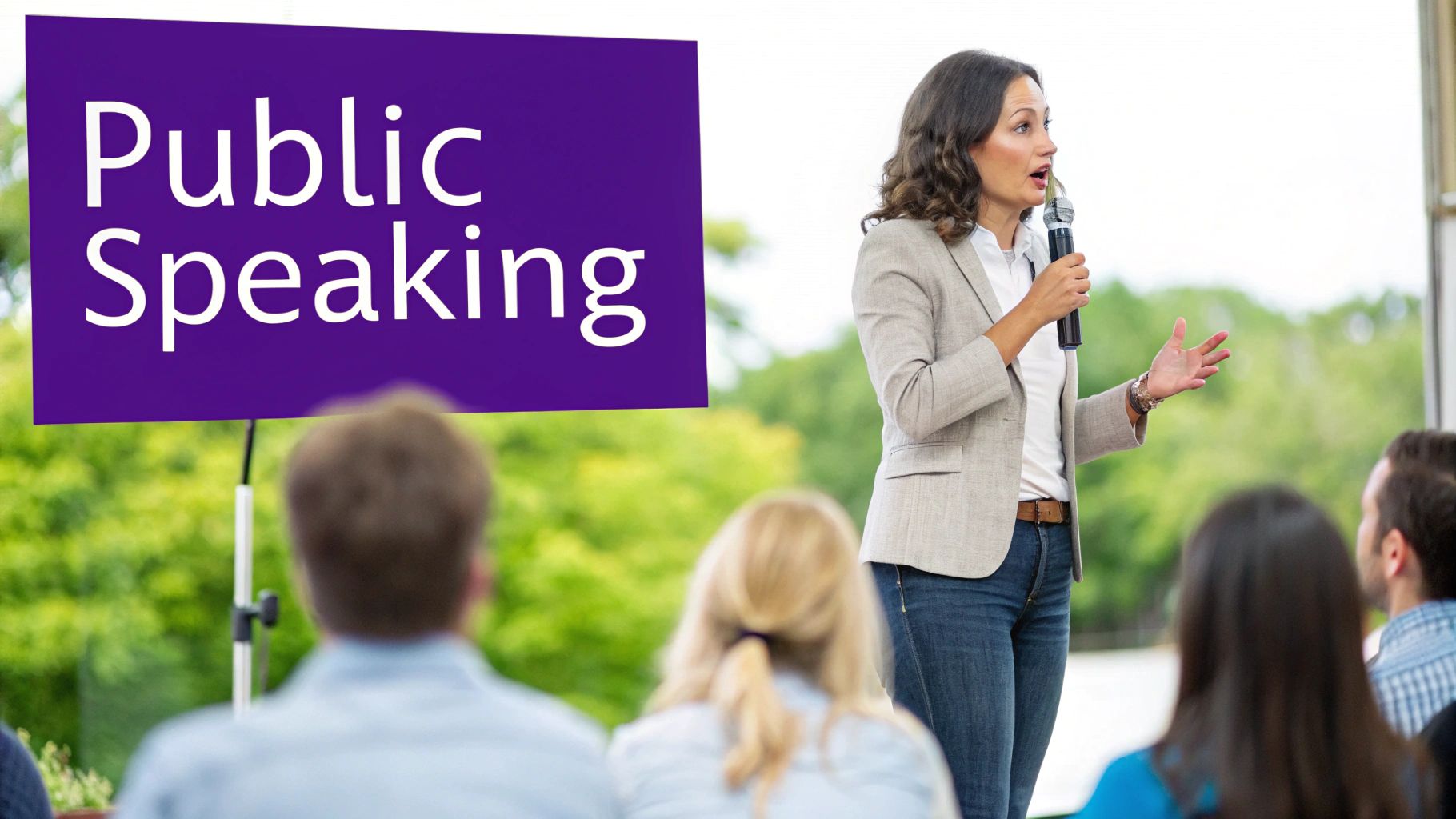
In a world filled with constant noise, the ability to truly listen is rare—and incredibly powerful. Think about it: the most influential person in the room isn't always the one talking the loudest. It’s usually the one who understands the most. This is the core of active listening, a skill that completely changes how you connect with people.
There’s a huge difference between passively hearing words and actively listening to understand the meaning, emotion, and intent behind them. Hearing is just a physical process. Listening, on the other hand, is both an intellectual and emotional one. Getting good at this is fundamental to building better communication skills in any professional setting.
Moving From Hearing to Understanding
Active listening means you’re fully dialed in on what's being said, not just passively absorbing the message. It's about listening with all your senses and giving the speaker your undivided attention. Ultimately, you're making the other person feel truly heard and valued.
Imagine a tense conversation with a coworker over a missed project deadline. A passive listener might just hear the complaint and immediately get defensive. But an active listener hears the frustration and starts asking questions to find the real problem. Maybe that coworker is completely swamped and needs support, not a confrontation.
This shift from defense to discovery is what makes active listening a professional superpower. It de-escalates conflict, builds trust, and uncovers crucial information that would otherwise stay buried.
Key Techniques for Active Listening
Putting active listening into practice takes deliberate effort. It won’t happen overnight, but weaving a few specific techniques into your daily conversations will make a massive difference. Here are two powerful methods to start with.
- Paraphrasing to Confirm Understanding: This is where you restate what the other person has said, but in your own words. It proves you were paying attention and gives them a chance to clarify any misunderstandings. Simple phrases like, "So, what I'm hearing is..." or "It sounds like you're concerned about..." work wonders.
- Asking Insightful, Open-Ended Questions: Closed questions—the kind you can answer with "yes" or "no"—tend to kill conversations. Open-ended questions, usually starting with "what," "how," or "why," invite the other person to share more detail and feel more engaged. For example, instead of asking, "Is the project on track?" try, "How are you feeling about the project's progress so far?"
These techniques are essential for building stronger professional relationships, a key part of the business networking strategies that can open doors throughout your career.
Active listening isn't just about waiting for your turn to talk. It’s about being present and creating a space where the other person feels safe enough to share their true thoughts without judgment.
Listening to Uncover True Needs
This skill is absolutely invaluable when working with clients. A client might come to you saying they need a "new website design," but an active listener digs deeper. By asking thoughtful questions, you might uncover that their real problem is a high bounce rate or low conversions—issues that a simple redesign won't fix.
This deeper understanding allows you to tackle the root cause, turning a straightforward request into a successful, high-impact project. To really nail this, you can explore the 6 principles to be a better listener, which offer a great framework for honing this skill.
When you focus on genuine comprehension, you transform from a service provider into a trusted advisor. That’s how you build loyalty and deliver exceptional results that speak for themselves.
Writing with Clarity and Impact
In a world drowning in emails, reports, and Slack messages, how you write is your professional reputation. Think about it. Every message you send is a chance to build trust and drive action—or just add to the confusion. Learning to write with clarity isn't some soft "nice-to-have" skill; it's absolutely essential if you want to make a real impact at work.
Effective writing is really about respecting the other person's time. It gets straight to the point, cuts out the fluff, and makes it dead simple for them to know what you need. This is a cornerstone of solid communication skills in any modern workplace.
Adopt the BLUF Principle
If you want to make a single, powerful change to your professional writing, start using BLUF. It stands for Bottom Line Up Front, a communication tactic borrowed from the military that flips traditional writing on its head. Instead of building up to a grand finale, you lead with your main point.
Your colleagues are busy. Your clients are busy. Everyone is busy. By stating your request or primary message in the very first sentence, you give them the most critical information immediately. They can always read the rest for context, but the core purpose is crystal clear from the get-go.
By putting your main point first, you ensure that even a quick glance delivers the essential information. This simple shift shows respect for your reader's time and dramatically increases the chances your message will be understood and acted upon.
Remember the last rambling, dense email you got? You probably had to read it two or three times just to figure out what the sender actually wanted. BLUF gets rid of that friction completely.
From Confusing to Crystal Clear
Let's walk through a real-world example. Imagine you need a colleague to review a project proposal before a big meeting.
Before BLUF (The Confusing Version):
Hi Alex,
Hope you’re having a good week. As you know, the quarterly strategy meeting with the leadership team is coming up this Friday. I've been working on the Q3 proposal for the "Project Phoenix" initiative we discussed a while back. I’ve incorporated the feedback from the initial brainstorming session and added the new budget projections. I think it’s in a pretty good place, but I’d love to get a second set of eyes on it. Would you be able to take a look when you have a moment?
This email forces Alex to wade through a sea of context just to get to the request. It's polite, sure, but it's not efficient.
After BLUF (The Action-Oriented Version):
Hi Alex,
Could you please review the attached "Project Phoenix" proposal and provide feedback by EOD Thursday?
This is for the Q3 strategy meeting on Friday, and I need to finalize the budget projections based on your input. The document is attached for your review.
Thanks!
The second version is a world of difference—it's direct, clear, and actionable. The request is impossible to miss, and all the necessary context is provided concisely right after. This small change makes a massive difference in how quickly you'll get a response. If you want to go deeper on this, exploring more business writing tips can give you even more powerful techniques.
Master Your Tone and Adapt Your Style
Clarity is king, but tone is the queen. Your writing should sound professional, but it also needs to sound human. Ditch the overly formal, robotic language that creates distance. Simple swaps like using "I'll" instead of "I will" or "let's" instead of "let us" make your writing feel much more natural and approachable.
On top of that, great communicators know how to adapt their style to the situation.
- Formal Reports: These require a structured, objective tone with hard data and clear analysis.
- Team Emails: You can be a bit more relaxed here, but the message should still be professional and unambiguous.
- Slack/Chat Messages: These are often brief and informal, but you still need to avoid sloppy phrasing that could lead to misunderstandings.
By mastering these elements—leading with your main point, structuring for clarity, and adapting your tone—you'll ensure your written communication always hits the mark.
Making Daily Practice a Natural Habit
Knowing which communication skills you want to improve is the easy part. The real growth happens when you start practicing them consistently, day in and day out.
The challenge isn't learning the theory—it's weaving practice into your daily routine until great communication becomes a reflex, not a conscious effort. It's about moving beyond vague goals like "I want to be a better listener" and embracing small, concrete actions you can take every single day.
Real habit formation is all about creating tiny, repeatable loops. Instead of waiting for a high-stakes presentation to work on your speaking skills, find low-pressure moments to practice. These small wins build momentum and make the whole process feel natural instead of forced.
Create Your Daily Practice Roadmap
Forget grand, sweeping changes. The secret to leveling up your communication skills lies in finding tiny moments to practice throughout your workday. Think of it as micro-dosing your improvement. Over time, these small, consistent actions compound into massive progress.
Start by picking just one or two specific areas to zero in on. Is it active listening? Writing with clarity? Speaking with more confidence? Once you know your focus, start hunting for opportunities to practice.
Here are a few practical examples to get you started:
- Volunteer to run the next team huddle. This is a perfect, low-stakes environment to practice structuring your thoughts. Try using a simple "What, Why, and How" framework to keep everyone aligned.
- Ask for direct feedback. After your next presentation, pull a trusted colleague aside. Ask them, "What was one thing that landed well, and one thing that could have been clearer?"
- Paraphrase a key takeaway in your next one-on-one. A simple, "So, to make sure I'm on the same page, your main priority is X," not only sharpens your listening skills but also ensures you're both perfectly aligned.
- Review an email you just sent. Take 30 seconds to re-read an important email. Could you have used the BLUF (Bottom Line Up Front) principle to get to the point faster?
Embrace Modern Tools for Faster Feedback
In the past, getting objective feedback on your communication style was a huge pain. You had to rely on busy managers or colleagues who might not have the time—or the desire—to give you honest input.
Today, technology gives you instant, private, and actionable insights to speed up your learning curve.
AI-powered speech coaches, for example, can analyze a recording of your voice and spit back immediate data on your pacing, use of filler words, and overall tone. These tools are like a personal gym for your communication skills, giving you a safe space to practice and refine your delivery before you ever step into a real meeting.
By using these tools, you can get the kind of targeted feedback that once required a professional coach, helping you identify and correct small habits that might be undermining your message.
This data-driven approach takes the guesswork out of improvement and lets you focus your practice on the areas that will actually make a difference.
The infographic below breaks down the core components that underpin strong interpersonal skills—the very skills you'll be honing with daily practice.
As you can see, empathy and self-awareness are rated as critical components. This tells us that the foundation of effective interaction is a solid understanding of both yourself and others.
Choosing the Right Practice Method
To build a habit that actually sticks, your practice plan has to fit your specific career goals and your daily schedule. Not every method will work for everyone. A developer who wants to write clearer code reviews has different needs than a salesperson who's honing their client pitches.
To help you build a personalized plan, I've put together a quick comparison of different practice methods. Think about which ones you can realistically fit into your day.
Daily Communication Practice Methods
| Practice Method | Primary Skill Targeted | Best Context for Practice |
|---|---|---|
| Running a Team Meeting | Verbal Clarity & Leadership | Daily stand-ups, weekly syncs |
| Seeking Direct Feedback | Self-Awareness & Nonverbal Cues | After presentations, one-on-ones |
| AI Speech Coaching | Verbal Delivery (Pacing, Fillers) | Private practice before meetings |
| Paraphrasing in Conversations | Active Listening & Empathy | Client calls, internal discussions |
| Applying the BLUF Principle | Written Clarity & Conciseness | Daily emails, project updates |
The goal here isn't to do everything at once. It's to pick a manageable mix of activities that directly contribute to your professional growth. This approach ensures you're not just learning theory, but actively applying and reinforcing new behaviors until they feel like second nature.
Looking ahead, this blend of practice and technology is becoming non-negotiable. The job market is shifting fast, and employers predict that by 2030, 39% of workers' core skills will be fundamentally different.
The World Economic Forum highlights that leadership, social influence, and resilience are becoming just as important as technical skills. This means communication is no longer a "soft skill"—it’s a critical capability that allows professionals to navigate increasingly complex digital interactions.
Common Communication Questions Answered
Even when you've mastered the basics, you're going to run into tricky, real-world communication challenges. This is where theory hits the road. Knowing how to navigate these tough spots is what really shows you’re leveling up your communication game.
Let’s tackle some of the most common questions professionals run into. I’ll give you clear, actionable answers you can put to use in your very next conversation.
How Do I Give Constructive Feedback Without Sounding Mean?
Giving feedback is easily one of the most delicate tasks we face at work. The entire point is to be helpful, not hurtful. A fantastic model I always recommend is the "Situation-Behavior-Impact" (SBI) framework. It’s a game-changer because it strips out judgment and sticks to the facts.
So, instead of saying something like, "You were really quiet and disengaged in that meeting"—which feels like a personal jab—try this instead:
- Situation: "During this morning's project sync..."
- Behavior: "...I noticed you didn't contribute during the brainstorming part..."
- Impact: "...and I was worried we might have missed out on some of your great ideas."
This approach is specific, objective, and keeps the focus on the outcome. It opens the door for a real conversation instead of just making the other person defensive. You're critiquing the action, not the person.
Pro Tip: Always deliver critical feedback in private. Public criticism is one of the fastest ways to kill trust and team morale. A one-on-one chat shows respect and a genuine desire to help someone grow.
What’s the Best Way to Deal with a Difficult Colleague?
Working with someone who’s unresponsive or just plain difficult can completely derail a project and cause a ton of stress. The key here is to be direct and professional, but don't let your frustration simmer in silence.
First off, always assume good intentions. They might be totally overwhelmed or just unaware there’s even a problem. Start with a direct but non-confrontational message.
For example, if someone's been ghosting your emails, you could say: "Hi [Name], just following up on my email about the Q3 report. I need your input by Friday to keep things moving. Is there a better way for me to reach you?" This puts the ball in their court while still sounding collaborative.
If that doesn't work and the behavior continues, document everything. Then, you can escalate the issue to your manager, making sure to frame it around the project's impact, not as a personal complaint.
How Can I Adapt My Communication for Remote Teams?
When you’re working remotely, you lose all that rich context you get from nonverbal cues. That means you have to be way more intentional with your communication to keep misunderstandings from popping up. Clarity and consistency are your absolute best friends here.
Here are a few strategies that I've seen work wonders:
- Over-communicate on purpose: What feels like over-communication is usually just the right amount in a remote setting. Get in the habit of summarizing decisions in writing after a video call and dropping that summary in a public channel for everyone to see.
- Match the medium to the message: Use email for formal stuff, chat for quick questions, and always jump on a video call for complex or sensitive topics. Seriously, don't try to resolve a conflict over Slack.
- Be explicit with your tone: Sarcasm and dry humor almost never land right in text. Use emojis (appropriately, of course) to add some emotional context and make your messages feel more human.
Making these small adjustments helps bridge the physical distance and ensures your message lands exactly as you intended, no matter where your team is. Honing these skills is also a massive advantage for job interviews, which are often remote these days. Our guide on job interview preparation tips has more advice on making a strong impression virtually.
Ready to build a professional presence that commands attention? With MakerBox, you can generate an optimized profile with AI-powered bios, photos, and content in just 30 seconds. Stop guessing and start connecting. Elevate your online presence with MakerBox today.




